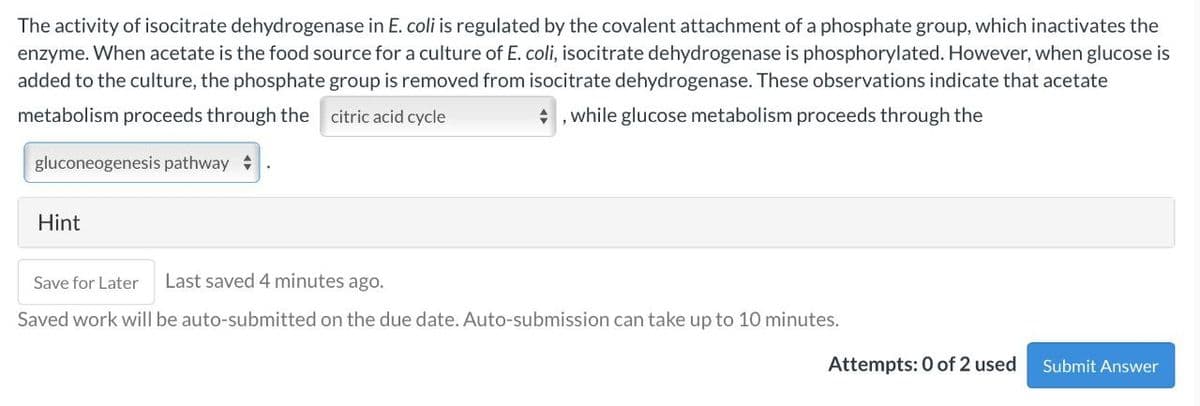The activity of isocitrate dehydrogenase in E. coli is regulated by the covalent attachment of a phosphate group, which inactivates the enzyme. When acetate is the food source for a culture of E. coli, isocitrate dehydrogenase is phosphorylated. However, when glucose is added to the culture, the phosphate group is removed from isocitrate dehydrogenase. These observations indicate that acetate metabolism proceeds through the citric acid cycle *, while glucose metabolism proceeds through the gluconeogenesis pathway
The activity of isocitrate dehydrogenase in E. coli is regulated by the covalent attachment of a phosphate group, which inactivates the enzyme. When acetate is the food source for a culture of E. coli, isocitrate dehydrogenase is phosphorylated. However, when glucose is added to the culture, the phosphate group is removed from isocitrate dehydrogenase. These observations indicate that acetate metabolism proceeds through the citric acid cycle *, while glucose metabolism proceeds through the gluconeogenesis pathway
Chemistry for Today: General, Organic, and Biochemistry
9th Edition
ISBN:9781305960060
Author:Spencer L. Seager, Michael R. Slabaugh, Maren S. Hansen
Publisher:Spencer L. Seager, Michael R. Slabaugh, Maren S. Hansen
Chapter23: Carbohydrate Metabolism
Section: Chapter Questions
Problem 23.66E: Lactate dehydrogenase catalyzes the following equilibrium reaction in both liver and muscle cells:...
Related questions
Concept explainers
Organic Chemistry of Metabolic Pathways
Metabolic pathways allude to the arrangement of chemical catalyzed reactions that lead to the transformation of a substance into the final product. Metabolic pathways incorporate a progression of reaction where the substrate is changed continuously and the transitional metabolites are persistently recovered.
Glucogenesis
Glucogenesis is a metabolic pathway in which glucose is produced from carbon substrates that are not carbohydrates. This process is observed in plants, animals, fungi, bacteria and other micro organisms. The general definition for glucogenesis or gluconeogenesis is as follows,
Question
The answer option for the drop down menu are citric acid cycle, gluconeogenesis pathway, and glyoxylate cycle.

Transcribed Image Text:The activity of isocitrate dehydrogenase in E. coli is regulated by the covalent attachment of a phosphate group, which inactivates the
enzyme. When acetate is the food source for a culture of E. coli, isocitrate dehydrogenase is phosphorylated. However, when glucose is
added to the culture, the phosphate group is removed from isocitrate dehydrogenase. These observations indicate that acetate
metabolism proceeds through the citric acid cycle
,while glucose metabolism proceeds through the
gluconeogenesis pathway
Hint
Save for Later
Last saved 4 minutes ago.
Saved work will be auto-submitted on the due date. Auto-submission can take up to 10 minutes.
Attempts: 0 of 2 used
Submit Answer
Expert Solution
This question has been solved!
Explore an expertly crafted, step-by-step solution for a thorough understanding of key concepts.
This is a popular solution!
Trending now
This is a popular solution!
Step by step
Solved in 2 steps

Knowledge Booster
Learn more about
Need a deep-dive on the concept behind this application? Look no further. Learn more about this topic, chemistry and related others by exploring similar questions and additional content below.Recommended textbooks for you

Chemistry for Today: General, Organic, and Bioche…
Chemistry
ISBN:
9781305960060
Author:
Spencer L. Seager, Michael R. Slabaugh, Maren S. Hansen
Publisher:
Cengage Learning


General, Organic, and Biological Chemistry
Chemistry
ISBN:
9781285853918
Author:
H. Stephen Stoker
Publisher:
Cengage Learning

Chemistry for Today: General, Organic, and Bioche…
Chemistry
ISBN:
9781305960060
Author:
Spencer L. Seager, Michael R. Slabaugh, Maren S. Hansen
Publisher:
Cengage Learning


General, Organic, and Biological Chemistry
Chemistry
ISBN:
9781285853918
Author:
H. Stephen Stoker
Publisher:
Cengage Learning

Organic And Biological Chemistry
Chemistry
ISBN:
9781305081079
Author:
STOKER, H. Stephen (howard Stephen)
Publisher:
Cengage Learning,